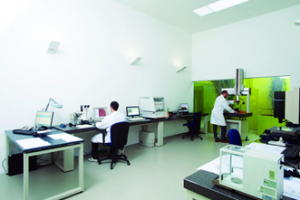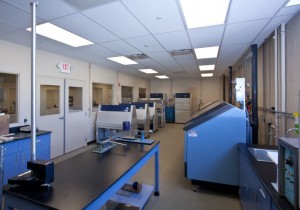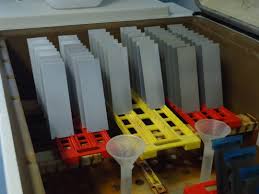 I have worked for 2 multi-national companies where I was part of growing or establishing an applications lab. And I’ve also worked at a smaller company where we both significantly grew the capabilities as well as moved the laboratory. Now, as a consultant, I’ve considered a lab to provide capabilities I can’t otherwise deliver, except through a third party subcontract (which I have done several times).
I have worked for 2 multi-national companies where I was part of growing or establishing an applications lab. And I’ve also worked at a smaller company where we both significantly grew the capabilities as well as moved the laboratory. Now, as a consultant, I’ve considered a lab to provide capabilities I can’t otherwise deliver, except through a third party subcontract (which I have done several times).
So, how do you address the need for a coatings laboratory? In this two-part article, we’ll consider two possible scenarios that will help us to explore the ins and outs of laboratory development, including the type of capabilities you may want or need for different types of services offered.
Looking for ingredients for your coatings formulations?
Prospector has 1000s of listings for coatings materials with technical data and the ability to request samples.
Get Material Data
Scenario #1
Your company has a modest laboratory but wants to expand its capabilities to develop business in other markets or perhaps enhance applications and testing for the current market.
Every lab needs the minimal applications and testing equipment. Besides the Cowles-type dispersators for coatings, you may need equipment for mixing high viscosity materials. Drawdown bars, wound wire bars and the necessary and appropriate substrates are needed. Paper charts such as Leneta are fine for most paints, but if you are testing industrial coatings, you will need panels for most tests. Wood coatings require wood coupons and a brush to apply them.
As you can see, the types of equipment needed add up quickly. But there are some things that can be outsourced. In Table #1, I have outlined the types of tests for architectural coatings, what should be done internally and what can be subcontracted. This is based on the frequency of testing, as well as the cost to purchase equipment vs. sending the testing out.
Raw material suppliers are more likely to be able to send out paints that contain their ingredients to test, than is a paint, adhesives or ink company who needs to perform a battery of tests to promote and market their coatings.
Interior architectural coatings

¹pH only waterbourne test
The above test regimen is not all-inclusive and varies by finish (flat to gloss), as well as water- vs. solvent-borne. Green represents what is recommended for in-house testing and orange is what can be outsourced if desired. This market segment is the least expensive for testing and equipment, but many formulation iterations translate into many tests run.
Exterior architectural coatings

As you can see, exterior architectural coatings have many similar tests to interior, with the most critical additions being weatherability which consists of color and gloss retention, chalking, cracking, checking, blistering, etc.
Larger resin companies maintain their own test fence sites, as do most paint companies. These are used for customer visits and often include competitive evaluations. The panel preparation and periodic evaluation and recording of results drives many companies to outsource. With the use of exceptional-quality digital pictures and the Internet, results can be provided almost immediately vs. the weeks or months it used to take to box up panels, return to the source, evaluate and then return to the contract test site.
I have worked in industrial areas where a simple pallet mounted horizontally or in another position, can quickly gather dirt resistance results. I have visited many sites where something similar has been erected for a quick visual.
Industrial maintenance coatings


This is the most vigorous of market segments, since coatings are expected to withstand particularly harsh environments. Coil coatings are projected to last 25 years or more. Coatings on oil rigs, ship bottoms, Floating Protection, Storage and Offloading (FPSO) platforms, wind turbine blades, etc. are all subjected to unique but severe environments. Similar are storage tanks for industrial chemicals, floor coatings, the leading edge of fixed wing and rotary craft (airplanes and helicopters). The tests above do not include special markets such as electronics and optics which have unique tests. Companies in those markets always run their own tests specific to their markets and rarely if ever outsource.

In the picture above, an impact tester is on the bench. In the far left corner are several QUV’s and a condensation chamber. On the right near side is at least one salt fog box. Other equipment is apparent but not identifiable.
To reiterate, as a raw material supplier, it may make more sense to outsource the majority of the long-term tests. Corrosion testing is very time-consuming and requires a fair amount of equipment maintenance, as does accelerated weathering. Exposure time is listed in hours; 5000 hours translates to over 30 weeks and 8000 hours is over 48 weeks. Most Salt Fog chambers are capable of running both ASTM B117 and ASTM G85, but it is generally recommended that each test is run on a dedicated piece of equipment. That means an outlay of about $100,000USD for 2. Many companies run ASTM B117 internally and send painted panels out for testing G85.

Since the goal as a raw material supplier is to develop and publish starting point formulations that demonstrate the value and performance of the materials, most paint companies accept data and results from suppliers. But most all of them will perform their own testing or slight modifications to ASTM tests to confirm results. However, in this situation, the advantage of using an outside, certified lab is valuable, since they are accepted as unbiased and true. By using an outside lab in some of your tests, you may shorten the evaluation time of an SPF at a coatings company if the data is from a reputable and known test lab.
It is appropriate here to say a few words about certification. Most everyone maintains their equipment to ensure that it performs correctly. Not everyone does the required maintenance or checks to meet ISO certification. If you do outsource testing, confirm that the testing is certified and by whom, if this is important to your company to generate data sheets. This requirement will typically cost you more, so if all you need is some preliminary, gross results for formulations, perhaps a certified lab is not needed.

If you also require analytical testing, the list of labs shrinks, as not every company has the capability and again, the ability to maintain certified equipment.
Although I focused on the paint segment of coatings, there is specialized equipment for ink, adhesives and construction products. Applications of inks and adhesives to film also requires expensive equipment and a fair amount of floor space.
In part two we’ll tackle the second scenario: setting up a lab from scratch.
The views, opinions and technical analyses presented here are those of the author or advertiser, and are not necessarily those of ULProspector.com or UL Solutions. The appearance of this content in the UL Prospector Knowledge Center does not constitute an endorsement by UL Solutions or its affiliates.
All content is subject to copyright and may not be reproduced without prior authorization from UL Solutions or the content author.
The content has been made available for informational and educational purposes only. While the editors of this site may verify the accuracy of its content from time to time, we assume no responsibility for errors made by the author, editorial staff or any other contributor.
UL Solutions does not make any representations or warranties with respect to the accuracy, applicability, fitness or completeness of the content. UL Solutions does not warrant the performance, effectiveness or applicability of sites listed or linked to in any content.



Nice article. By “Drawdown” I would guess that you mean to include Hegman Fineness? The Hegman gage will tell a lot about how well the minerals are dispersed, especially the TiO2, and whether you have agglomeration or other wet film issues.
Although I was referring to application bars, certainly a Hegman bar is critical in the determination of pigment dispersion. Thanks for the feedback.
One other vital piece of equipment is either a GE Brightness or Hunter L a b type color meter. This is necessary to not only compare inert fillers in white paints but for color of tinted paints, to do opacity and fade resistance for exteriors, etc.
Janis